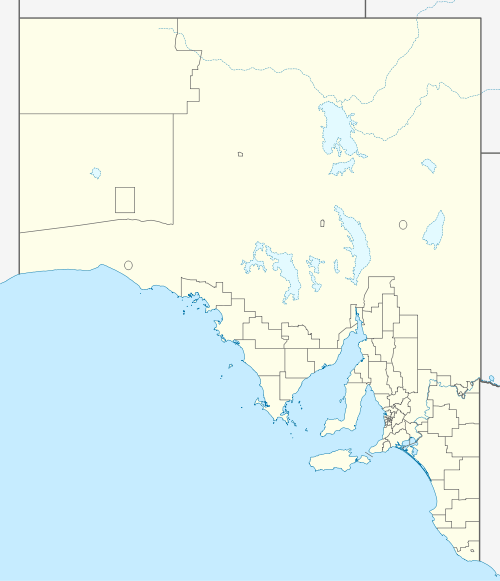Port Stanvac, South Australia
Port Stanvac is a former port and oil refinery in the suburb of Lonsdale south of Adelaide city centre in South Australia. It was operated by Exxon Mobil between 1963 and 2003. Since its closure, the port and adjoining land based refinery site are advancing through decommissioning processes.

Oil refinery
It was announced in 1958 that a refinery would be built at Port Stanvac and crude oil was first processed there in 1963. Its designed capacity was 3.3 million tons per annum. The refinery, owned by Exxon Mobil, closed in 2003. Its closure resulted in the loss of over 400 jobs. Decommissioning and remediation of the 239 hectare site is ongoing and is expected to continue until 2019. Once the site has been decommissioned, the land is expected to be sold in phases. The demolition of the former oil refinery was scheduled to begin in early 2012 and be completed by the end of 2013. Demolition was completed in 2014.[2]
Port Stanvac jetty

The Port Stanvac jetty is 670 metres long, and since the refinery's closure in 2003 remains with an exclusion zone for the purposes of public safety. The structure terminates in waters 12 to 15 metres deep.[3]
In October 2015, the South Australian government committed to retaining the existing 215 metre rock groyne adjoining the jetty, but according to Exxon Mobil "had not identified a viable alternate use for the defunct structure." Mobil agreed to fund upgrade works estimated to cost $5.7 million to ensure that the groyne would be safe prior to opening it for public access.[4] The jetty structure itself is expected to be demolished.
The Southern Times Messenger previously reported that Exxon Mobil had offered the Port Stanvac Jetty to the City of Onkaparinga. This was to allow anglers and divers access in the hope that one day the jetty could be used for recreational fishing and diving.[5] Onkaparinga Mayor Lorraine Rosenberg has said any responsibility for the jetty should fall to the Government of South Australia. Shore based diving opportunities near suburban Adelaide are few, making the jetty structure a prospective new dive tourism attraction. Onkaparinga city development manager Terry Sutcliffe said one of the council’s aims was to see the jetty used as a port for local industries and said the council would need to consider maintenance and liability costs if it chose to take over the jetty.
Oil spills
A number of oil spill events occurred at or near Port Stanvac during the refinery's operating life.
- One such incident occurred on 20 July 1978 when oil was discharged from the vessel Aphrodite into Gulf St Vincent.[6]
- On 22 January 1982, oil was spilled from the tanker Esso Gippsland during unloading at the Port Stanvac jetty. The slick was sprayed with chemical dispersant, applied from the air. Oil later washed ashore at Seaford and Aldinga Beach.[7]
- On 28 June 1999, approximately 230 tonnes of oil was discharged from an offshore loading connection to the refinery. The discharge occurred 2 nautical miles offshore.[8] The oil spill response in 1999 involved aerial spraying of 26.1 cubic metres of chemical dispersant and the employment of approximately 150 people in beach cleanups at beaches at Sellicks Beach and Aldinga Beach.[9]
Grain terminal
The construction of a grain export terminal was proposed by the Australian Wheat Board and Australian Barley Board in 2002. The proposal did not progress, due to the progression of the Outer Harbor AusBulk grain terminal in the existing port precinct area. This was due to the additional infrastructure costs, and impacts on the community of additional freight movements in residential areas.[10]
In popular culture
The South Australian band The Dairy Brothers wrote a song called Port Stanvac for which they also produced a music video.
References
- "Search result for "Port Stanvac Oil Refinery" (Record no SA0040704) with the following layers selected - "Suburbs and Localities" and " Place names (gazetteer)"". Property Location Browser. Government of South Australia. Archived from the original on 12 October 2016. Retrieved 6 June 2016.
- "Mobil Adelaide Refinery". www.exxonmobil.com.au. Retrieved 17 March 2016.
- "Port Stanvac Wharf Fact Sheet" (PDF). Mobil. Retrieved 17 March 2016.
- "Mobil Adelaide Refinery - Port Stanvac wharf". www.exxonmobil.com.au. Retrieved 17 March 2016.
- "Archived copy". Archived from the original on 9 October 2011. Retrieved 23 March 2012.CS1 maint: archived copy as title (link)
- "Oil-spill fine - The Canberra Times (ACT : 1926 - 1995) - 26 Aug 1980". Trove. Retrieved 17 March 2016.
- "Esso Gippsland oil pollution incident, Port Stanvac, 22 January 1982 - Australian Maritime Safety Authority (AMSA)". www.amsa.gov.au. Archived from the original on 19 March 2014. Retrieved 21 April 2016.
- "Response to the Port Stanvac oil spill [electronic resource] / Marine Incident Investigation Unit. - Version details". Trove. Retrieved 17 March 2016.
- Julian, Michael (14 April 2000). "Response to the oil spill at Port Stanvac on 28 June 1999 - Report of the Incident Analysis Team - April 2000" (PDF). AMSA. Archived from the original (PDF) on 28 March 2016. Retrieved 17 March 2016.
- "Deep-sea grain port for Adelaide" (PDF). Cabinet - Subjects for consideration. Department of Premier and Cabinet (South Australia). 8 October 2002. Archived from the original (PDF) on 7 March 2016. Retrieved 5 June 2016.